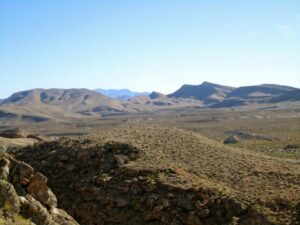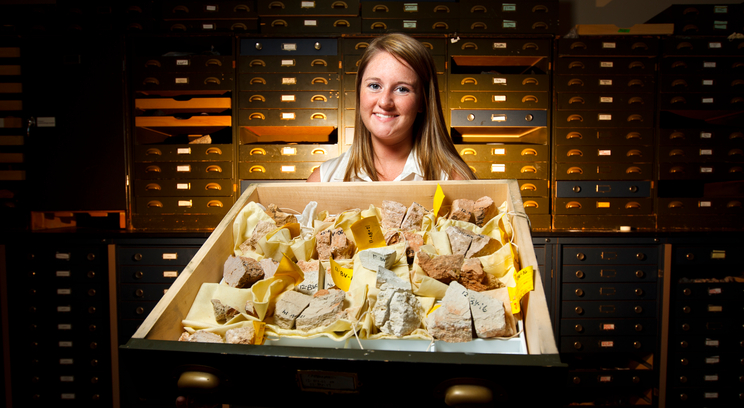The ground we stand on is not as solid and unchanging as it may seem. Continents float about the earth's outer crust on tectonic plates like enormous ships sailing on a slow-moving current. Some continents cover two plates. And sometimes plates collide or move apart from each other, resulting in earthquakes.
These basic geologic principles launched budding geologist Jane de Lambert's research project, "A Detailed Study of the Upper Horse Spring Formation in the Lake Mead Region of Nevada: Ancient Lakes and the History of the Central Basin and Range."
De Lambert, a junior at St. Thomas, studied the geologic history of the Lovell Wash, the youngest, or "upper," of the four members that constitute the sprawling Horse Spring Formation in southern Nevada.
Her goal was to "undo the faulting to understand the original geography of the area and, by doing so, unravel the geologic history of the region," she said, adding, "this exercise also can be important for resource exploration because these types of environments are similar to other areas that have been found to contain important petroleum and other mineral resources. ... There's an economic viability aspect, which brings an unexpected and interesting dimension to this kind of research."
Led by her adviser, Dr. Lisa Lamb, professor in the College of Arts and Sciences' Geology Department, de Lambert, with two other students from St. Thomas, roughed it "in the middle of nowhere," over spring break last semester. "We rode these big trucks as far as we could, then hiked a mile in and set up camp near the formation," she said.

Lovell Wash, also known as the upper Horse Springs Formation, stretches across the middle ground in this photo taken last March in Nevada by Jane de Lambert.
During the day, de Lambert took notes on her observations of the upper formation, identifying rock types and minerals and "hacking off rock samples (limestone, gypsum and volcanic ashes) with a rock hammer" in stratographic units, layers of rock that provide a chronological timeline for the formation's geologic history; afterward, she would record the GPS coordinates where each sample was collected so it later could be geochemically analyzed.
The samples she collected are important because they have, in effect, "recorded" a large portion of the deformation that occurred as a consequence of the tectonic shifts of the time.
History of the Horse Spring Formation
"There was volcanic activity (in the area), and we can send our samples to the lab to date the ash fall from the eruptions," de Lambert noted.
"Twelve to 16 million years ago extreme tectonic stretching (over time) altered the entire Southwestern desert region of the United States. Sediments were deposited both during and after this activity, creating complicated basins and mountain ranges," de Lambert explained. "After deposition, these rocks were further distorted by even more tectonic activity."
The time frame she studied falls into the Miocene epoch (23 to 5 million years ago), a period known for spreading grasslands and retreating tropical ecosystems.
The Lake Mead region of Nevada contained very little biologic activity during that period. Before the tectonic shift that initially created the Horse Spring Formation, the area consisted of "small, shallow lakes with saline water," de Lambert said. "It was a very harsh environment, which would explain why no fossils have been found in the area."
In partnership with Lamb, she is still in the process of re-creating the basin architecture, using a variety of methods, including detailed mapping, geochemical analysis of the ancient lake sediments, and correlation between rock unit beds across the area.
"There wasn't one dominating event that changed the topography; tectonics and changes in structure are continuous and ongoing; however, the particular environment and tectonic setting which we are most interested in studying is when ancient lakes were present in the area. These lakes created the rocks that we study today," de Lambert explained.
Her research culminated at the Geological Society of America's national conference in October in North Carolina, where she presented her findings.
De Lambert said, "Being a part of this research project has been the highlight of my undergraduate career thus far. I have learned so much from both my field experiences and my analysis in the UST labs; in addition, this project has played a large role in solidifying my post-graduate plans" – a Ph.D. in environmental health.
"It also has been thrilling to be among the first to research this formation and document these rocks," she added.
An individualized major in "geology and human health," she changed course slightly this semester because she "really identified with a medical geology course I'm taking this semester," in which she studies how the earth and toxic chemicals in the environment affect health (for example, the lack of minerals in soft drinking water can lend detrimental effects to cardiovascular health).
She credits her study, which was funded by a Young Scholars Grant, for teaching her how to work independently: "Conducting my own research project without the day-to-day instruction of a typical classroom, required that I think critically and problem solve when I was working alone."
The Young Scholars Program awards individual grants to undergraduate students at the University of St. Thomas who are interested in spending an entire summer working closely with a professor on a significant research project or creative activity .







